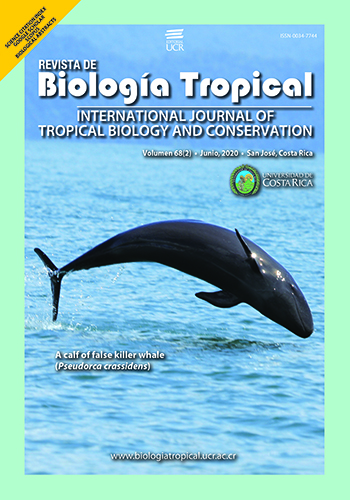Resumen
Introducción: Recientemente ha tomado relevancia el uso de especímenes de museo como fuente de información genética para desarrollar estudios que resuelven preguntas taxonómicas, ecológicas, demográficas y evolutivas a diversas escalas temporales y geográficas. Sin embargo, material genético obtenido a partir de ejemplares depositados en colecciones biológicas es poco usado, debido al deterioro natural del ADN preservado en dichos ejemplares, de manera que la obtención de material genético de calidad es demandante en términos de tiempo y dinero. Objetivo: Usando material de museo, identificar una secuencia mini-barcode que pueda ser empleada en la determinación taxonómica, y que a su vez suministre información que permita la estimación de relaciones filogenéticas de especies del género Bombus. Métodos: se estandarizó el protocolo de extracción de ADN a partir de la extremidad mesotoracica derecha y/o una muestra de músculo torácico de 96 especímenes depositados en la colección LABUN entre 7 y 38 años atrás. Las diferentes combinaciones de oligonucleótidos evaluadas permitieron amplificar fragmentos de 152 a 407 pares de bases (pb) del gen mitocondrial Cytochrome Oxidase I (COI). Usando como plantilla un grupo de 31 secuencias amplificadas a partir de especímenes recolectados recientemente, los fragmentos obtenidos de los especímenes del museo fueron ensamblados y analizados en un marco filogenético. Además, se realizó un análisis de red de haplotipos para evaluar en detalle las relaciones entre los haplotipos mitocondriales resultantes. Resultados: Se determinó un mayor éxito de extracción de ADN a partir de muestras de extremidad depositadas a partir del año 1982. Entretanto, la amplificación exitosa de fragmentos de más de 300 pares de bases (pb) se logró principalmente en muestras depositadas en fechas posteriores a 1999, lo que indica una mayor integridad del material genético recuperado de individuos de 19 años de recolección en adelante. Aunque todos los fragmentos evaluados pueden ser empleados como mini-barcode, solo con uno se obtiene una topología similar a la observada con el fragmento completo. Se detectó una gran variacion genética, particularmente al interior de las especies Bombus atratus y B. funebris, en las que se reveló una clara estructura filogeográfica. Conclusiones: Se obtuvieron nuevas secuencias de códigos de barras mediante extracción de ADN y protocolo de amplificación de muestras de museos. Además, se generó nueva información sobre la variabilidad genética intraespecífica, detectando la presencia de haplotipos mitocondriales únicos que podrían constituir Unidades Significativas Evolutivas sujetas a conservación. Dicha información es de vital importancia para formular estrategias de conservación para estos polinizadores en Colombia.
##plugins.facebook.comentarios##

Esta obra está bajo una licencia internacional Creative Commons Atribución 4.0.
Derechos de autor 2020 Ingrid Astrid Lotta-Arevalo


